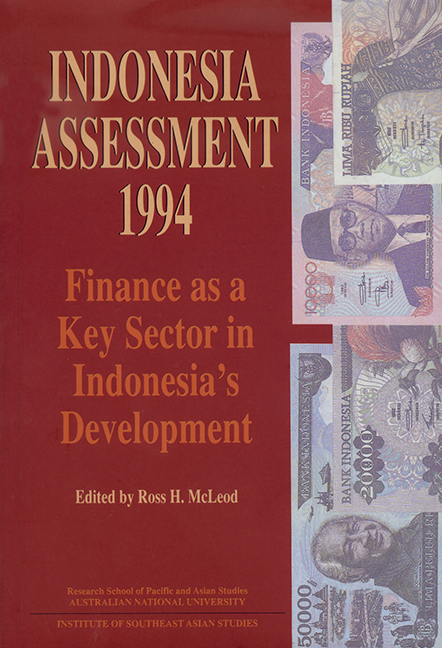Book contents
- Frontmatter
- Contents
- Tables, figures, appendices
- Foreword
- Glossary
- Contributors
- Acknowledgements
- 1 Introduction
- PART A ECONOMIC AND POLITICAL DEVELOPMENTS
- PART B FINANCE AS A KEY SECTOR IN INDONESIA'S DEVELOPMENT
- I The Reform Process
- 4 Financial reform: achievements, problems and prospects
- 5 Comments on Professor Wardhana's paper
- 6 The sequencing of economic deregulation in Indonesia
- II Monetary and Exchange Rate Policy
- III Banking Sector Reforms
- IV Domestic and International Capital Markets
- V Small-scale Finance
- References
- Index
5 - Comments on Professor Wardhana's paper
from I - The Reform Process
Published online by Cambridge University Press: 21 October 2015
- Frontmatter
- Contents
- Tables, figures, appendices
- Foreword
- Glossary
- Contributors
- Acknowledgements
- 1 Introduction
- PART A ECONOMIC AND POLITICAL DEVELOPMENTS
- PART B FINANCE AS A KEY SECTOR IN INDONESIA'S DEVELOPMENT
- I The Reform Process
- 4 Financial reform: achievements, problems and prospects
- 5 Comments on Professor Wardhana's paper
- 6 The sequencing of economic deregulation in Indonesia
- II Monetary and Exchange Rate Policy
- III Banking Sector Reforms
- IV Domestic and International Capital Markets
- V Small-scale Finance
- References
- Index
Summary
It is a great pleasure to share the platform with such a distinguished economist and, could I say, valued friend. But it is with some trepidation that I comment on this paper, because not only was Pak Ali present at the creation of the Indonesian financial sector as we now know it, but he was mid-wife at its birth and its guardian as it grew up.
While on this subject of the Good Old Days, let me say that I resist the idea that the development of the Indonesian financial sector started with the regulatory reform of June 1983, because I believe its true origins go back further and can be found in the early days of the New Order.
Some highlights of the process of financial reform
The 1960s: early reform
The main achievement of this period, of course, was the halting of hyperinflation. Without this achievement, the financial sector could not have been built. McKinnon (1973:3) captures the essence of this when he says ‘[O]nce the monetary linchpin is put in place, appropriate strategies for liberalizing foreign trade and rationalizing domestic tax and expenditure policy follow naturally’. In this early period, also, came the removal of controls on foreign capital flows and the introduction of what, for its day, was a high- tech financial instrument—high interest rate time deposits.
Innovations in exchange rate policy
Also going back to this early period, Indonesia had a brief flirtation with floating exchange rates, long before they became fashionable. Just as others, in a later era, recognised the problems of a floating exchange rate, Indonesia moved to a greater degree of fixity during the 1970s. Then came the three bold devaluations. Not all commentators were quick to see the underlying logic of these changes, but many now see them as a great success in that they reoriented the economy towards export growth, driven by very favourable international competitiveness.
- Type
- Chapter
- Information
- Indonesia Assessment 1994Finance as a Key Sector in Indonesia's Development, pp. 94 - 100Publisher: ISEAS–Yusof Ishak InstitutePrint publication year: 1994

